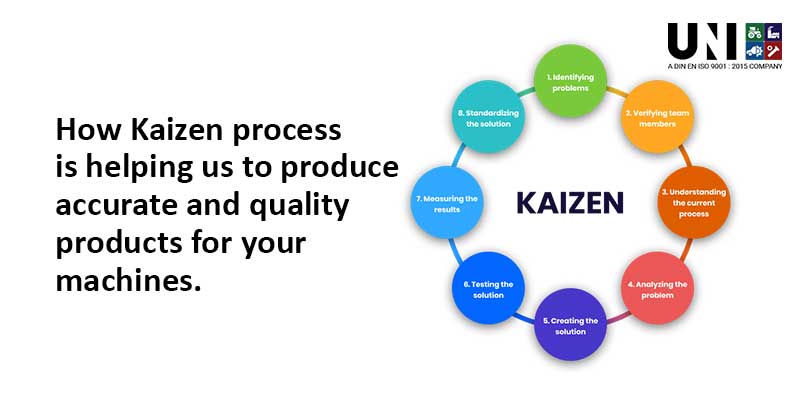The word “kaizen” is a Japanese word that denotes “change for the better.” In common understandable words, kaizen is – improvement and incorporates both short- and long-term processes. In manufacturing, kaizen states to brainstorming ideas and applying daily activities that uninterruptedly improve progressions. It involves all employees –from higher-ups to plant-floor employees. Action plans consist of organization-focus teams and events set on refining explicit areas within the organization.
The Kaizen Approach
Since kaizen is about continuous improvement, it’s not just a one-time event but rather a deliberate mindset of always thinking of ways to improve efficiency. This approach to continuous improvement is typically broken down into six steps.
Brainstorm: With a cross-functional team, think of ways to make upfront, repeatable processes that will advance specific activities.
Measure: Ensure processes are effectual using quantifiable data. This is a trackable metrical you can use to measure improvement.
Compare: Compare the data from your measurements with your gritty requirements.
Innovate: Continuously search for new and improved ways to do the same work and achieve the same result.
Standardize: Once everyone is satisfied with a tested new idea or process, make it repeatable and straightforwardly followed by everyone.
Repeat: Start the approach over again.
This approach to kaizen ultimately becomes part of the mindset of the complete organization, making it second nature. Suggestion schemes are a great way to drive kaizen and the idea of continuous improvement.
1. Enhanced quality
2. Shorter delivery times
With a Kaizen culture’s focus on development, one of the advantages is going to be improved quality of one’s product. As those closest to manufacturing processes find areas where product quality or competence are negatively affected, the organization is able to implement variations that reduce waste and eliminate flawed products.
As the team finds ways to make developments more efficient, activities that don’t add value are cut away, hindrances to delivery are removed, and processes are made more efficient. The end result is faster delivery times, which has the added advantage of increasing client satisfaction while abolishing sources of frustration for the company itself.
3. Reduced costs
4. Effective management
Naturally, by dropping waste and abolishing non-value-added activities, the costs of running production procedures and other services are reduced. Companies that emphasise improvements find ways to spend less time and money on their methods and therefore benefit from lower overhead.
Improvements aren’t inadequate only to physical production processes or workflows. Kaizen focuses on nonstop change for the better in all areas of business operations, including management performance. Ways in which management practices can be improved contain:
- Implementing a more active process
- Refining training
- Streamlining managerial processes
- Refining planning practices
- Streamlining roadmap
- Facilitating communication and reporting
- Cleaning up documents and data storage
5. Increased safety
6. Improved morale
Safety is a major worry in many industries. A Kaizen culture will be subtle to areas where safety is put at risk and take procedures to alleviate those risks. It may be as simple as putting labels on cleaning equipment or providing safety training. It may be as tangled as installing safety features on equipment or refining maintenance practices.
The cultural shift required by the adoption of Kaizen helps everybody take more accountability for their work. In addition, communication advances, and everyone plays a role in making progress happen. The end result often results in improved workplace morale.
Conclusion
Kaizen is to some degree you can benefit from fast as an individual. But approval of the approach with your team will take a rigorous effort. Here are some suggestions to help make kaizen work with your team:
- Allow everyone to submit their suggestions for enhancements.
- Establish your complete kaizen approach and controls, creating a system to follow that everyone understands.
- Reward ideas, as the more ideas you create, the more kaizen is at work in the daily life of your team.


